The hardest part about the whole procedure is actually mounting
the dial-indicator and stand!
The commonly available magnetic
stands, with all their arms and clamps, are bulky and interfere with the
bellhousing as you attempt to rotate the flywheel. We spent a good
hour trying to figure out how to mount the indicator so that it fits in
the bellhousing without interfering with anything. We found that the best
way was to mount the gauge on the stand using only one of the clamps, as
shown in the photo to the right. We tried using the flexible "snake" type
of indicator stand, but it doesn't bend tight enough, as you can see here
the gauge needs to be at a 90 deg. angle on the stand.
We found that the
best way to mount the magnetic base to the flywheel is to remove two
flywheel bolts directly across from one another. This allows the base to
sit flat on the flywheel and gives you room to position it as close to the
crank centerline as possible. Be sure to install the Lakewood blockplate
behind the flywheel, and secure the bellhousing with all six bolts before
you measure the alignment! We tried measuring the alignment without it and
found our numbers to be way off.
The most
important thing to check for when setting up the dial-indicator is to
ensure the tip makes contact with the bore lip for the full 360
degrees! The bore of the T5 bellhousing turns out to be just about the same
diameter as the length of most dial indicators. Thus while it may look
like the indicator tip is contacting the lip, it may not be and you'll get
false readings. We ran into this problem at least a half-dozen times. You
should watch the top of the plunger, if it looks bottomed out the other
end is most likely not making contact.
Once the gauge is mounted
correctly, set the bezel to zero and slowly rotate the crank (or have a
friend do so.) As you can see in this photo you wont be able to always
read the gauge as it rotates, so use an inspection mirror. If you rotate
the crank and find that you're getting high-readings through half the
travel, then the indicator goes back to zero for the remaining 180
degrees, it means the indicator is not contacting the lip. We'd see as
much as .030" runout at the halfway point, then the indicator would come
back to zero. The activity of the indicator needle should emulate a mirror
image, where for example, you get 0.010" travel above zero and 0.010"
below zero. In this example the total travel would be 0.020", divided by
two, indicats 0.010" misalignment.
Measure until you
get repeatable results! On our first attempts we were seeing numbers
all across the board, from 0.010" to as much as 0.040". We found that if
you only installed two of the six bellhousing bolts, while it may seem
secure, the bellhousing is not flush with the block, which gives a false
misalignment. We recommend that when measuring alignment you install both
the bellhousing and blockplate and use all six bellhousing bolts, torqued
properly. Also make sure the dowels in the block and mating surfaces are
clean and free of any crud or paint. Once we went through these
precautions the runout for both our bellhousings were within
specifications. We removed the bellhousing and remounted it three more
times to ensure we could reproduce the same reading each time. Only then
can you be confident you have an accurate measurement. If you are not sure
and you install corrective dowels, you may make the problem worse.
Correcting misalignment
If you have between
0.005" - 0.025" misalignment, you can correct it with either offset dowels
or welding on washers over the dowel holes in the bellhousing itself. The
offset dowels come in 0.007", 0.014" and 0.021" offsets. Insert them in
the block, and use a screwdriver to 'clock' them in the right spot. You'll
need to measure again to make sure you're within spec.
If you're
bellhousing requires more offset than this to correct the problem, or you
want a permanent fix (the dowels need to clocked every time you remove the
bellhousing) you can weld on alignment washers over the dowel holes in the
bellhousing. However we would be very skeptical of any misalignment over
0.020", this would indicate to us that perhaps the measurement is
incorrect or there is a problem with the block or bellhousing. Before
welding any washers we'd advise that you obtain another Lakewood
bellhousing and recheck, or check your bellhousing on another block. To
weld the washers you'll have to slightly enlarge the dowel holes in the
bellhousing, then bolt the bellhousing to the block using the supplied
longer dowels. Take a measurement, then carefully tap the bellhousing into
position with a mallet, re-measure, and do this until it is centered.
Finally torque the bolts, re-measure to make sure you didn't disrupt the
alignment, then slip the washers over the dowels an weld them in
place.
Other Modifications
Because of the larger than stock
size of all Lakewood bellhousings, it is inevitable that you will have
some sort of clearance problem, be it with headers, clutch linkage,
exhaust, etc. The solution for most of these interference problems is to
grind material off the bellhousing to gain the needed space. Technically the manufacturer, the NHRA and SFI consider any
modifications as voiding the SFI certification. However the reality is
very few cars can fit a larger bellhousing without slight modification. We
had to drill two holes to mount our clutch fork fulcrum because we're
using the early style mechanical clutch linkage. (The Lakewood T5
bellhousing is set up for the cable clutch mechanism.)
In addition,
because the 302 in Project 11.99 is a 1990 block, there is no mouting
location for the block pivot for the clutch equalizer bar. We'd been using
a Windsor-Fox adapter designed for the stock bellhousing, so we had to
adapt it to the Lakewood. This required some clearancing of the flange and
also cutting some standoff spacers as seen in the photos.
| Shown is the Windsor-Fox pivot adapter for using late model
blocks with early style clutch mechanisms. Note how the stock
bellhousing has raised bosses. Because the scattershield flange is
flat we had to measure and make spacers so the adapter is at the
correct height. We found a steel bushing and cut in half, then
ground it to the correct height. Note (3) we had to grind the flange
to obtain clearance for the adapter |
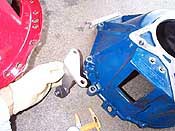 |
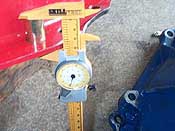 |
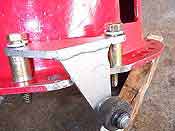 | |
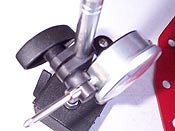 |
| Mounting the dial indicator as shown worked the best for
us. |
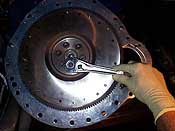 |
| Install the Lakewood block plate, then the flywheel. Remove
two flywheel bolts across from each other to allow the magnetic
indicator stand to sit square in the center of the
flywheel. |
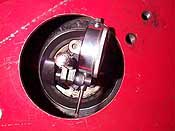 |
| The
dial indicator must contact the lip for the full 360 degrees! You'll
need a small mirror to read the gauge as it turns over. |
 |
| Jim
takes a nap after removing and installing the 30 pound bellhousing
for the tenth time. |
 |
| In
order for the bellhousing to contain an explosion the supplied
hardware must be installed in its proper location as listed in the
instructions. |
 |
 |
| Offset dowels (top) and weld-on washers available from
Lakewood. |
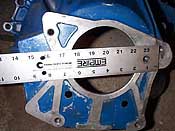 |
| Because we're using the early style mechanical clutch
linkage (rather than a cable operated clutch) we had to transfer the
spacer
block from our stock bellhousing to the Lakewood. Rather than
re-measuring where to drill the mounting holes, we fabbed u pa
template by bolting a straight edge to the pivot boss in the stock
bell and drilling two holes in the ruler corresponding to the holes
for the spacer block.... |
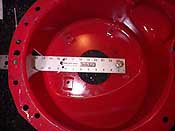 |
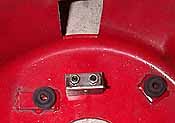 |
| ....then we simply bolted our ruler "template" to the pivot
boss in the Lakewood and drilled the two holes. |
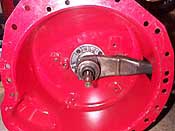 |
| Here's the mechanical style clutch fork mounted in the T5
scattershield | |














